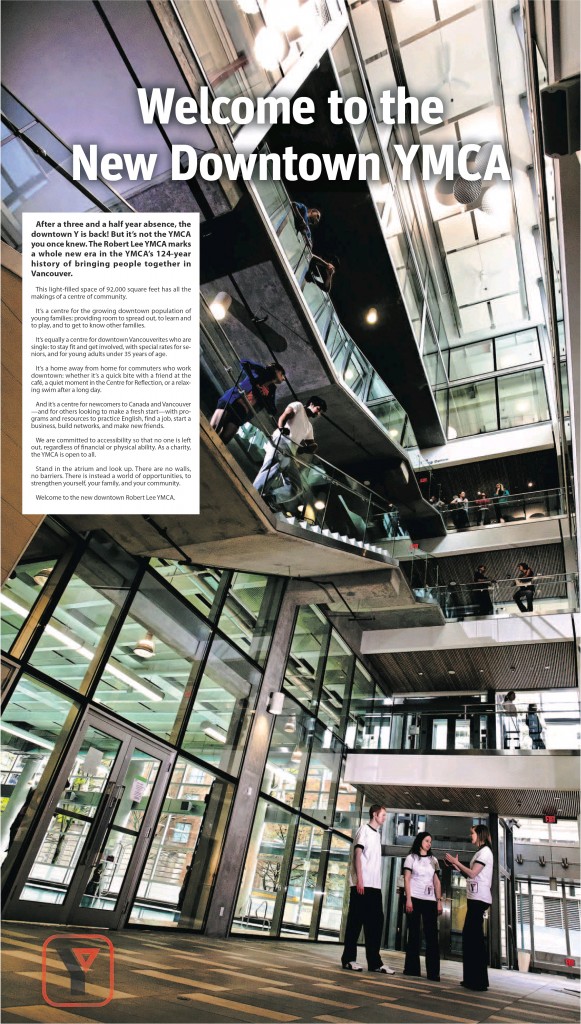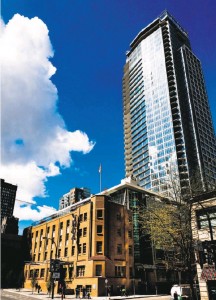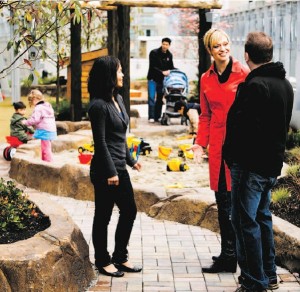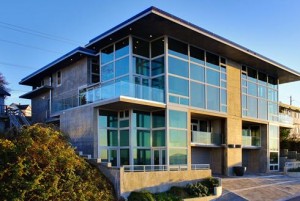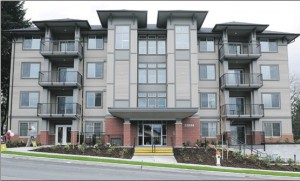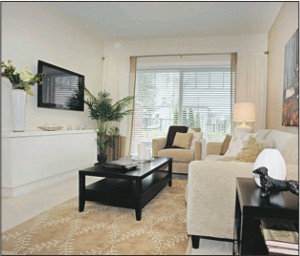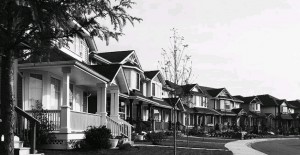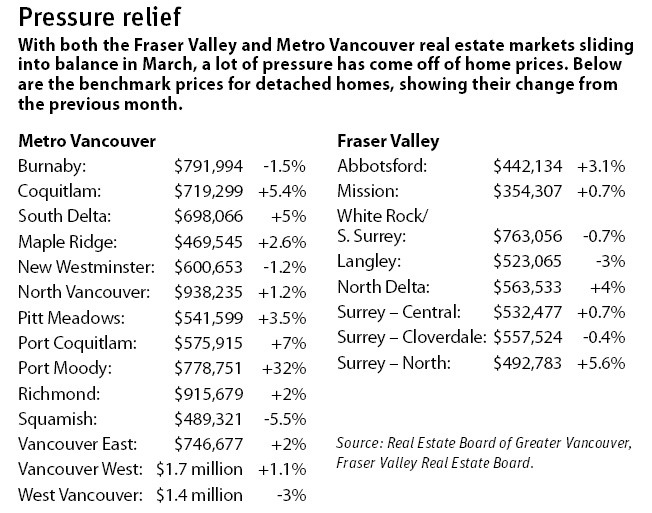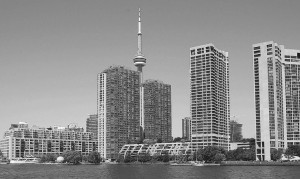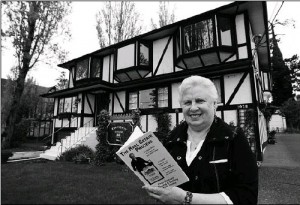Sun
After a three and a half year absence, the downtown Y is back! But it’s not the YMCA you once knew. The Robert Lee YMCA marks a whole new era in the YMCA’s 124-year history of bringing people together in Vancouver.
This light-filled space of 92,000 square feet has all the makings of a centre of community.
It’s a centre for the growing downtown population of young families: providing room to spread out, to learn and to play, and to get to know other families.
It’s equally a centre for downtown Vancouverites who are single: to stay fit and get involved, with special rates for seniors, and for young adults under 35 years of age.
It’s a home away from home for commuters who work downtown: whether it’s a quick bite with a friend at the cafe, a quiet moment in the Centre for Reflection, or a relaxing swim after a long day.
And it’s a centre for newcomers to Canada and Vancouver –and for others looking to make a fresh start–with programs and resources to practice English, find a job, start a business, build networks, and make new friends.
We are committed to accessibility so that no one is left out, regardless of financial or physical ability. As a charity, the YMCA is open to all.
Stand in the atrium and look up. There are no walls, no barriers. There is instead a world of opportunities, to strengthen yourself, your family, and your community.
Welcome to the new downtown Robert Lee YMCA.
The YMCA means many things to many people. To some, it’s the camp they went to as a child, where they tasted their first bit of independence from home. To others, it’s the place they go to workout, where they meet with friends and de-stress from the day. To still others, it’s the caring environment where they safely leave their children as they head out to work.
Throughout our 124-year history, we’ve seen that no matter what people’s interests are, they want a life that’s balanced, and they want to support each other in getting there. The biggest thing holding them back is the lack of opportunities to connect.
We thought a lot about what we can do to help make that happen when we were rebuilding the downtown YMCA. In the new Robert Lee YMCA, we’ve created a place where people can make those connections while pursuing a healthy and balanced way of life.
It’s a beautiful facility–bright, modern, and designed to be inclusive and accessible to all. But it’s what is inside that truly embodies the spirit of the YMCA: people of all ages and from all walks of life coming together to discover new opportunities, engage with others, and collectively strengthen our community.
It is only through the support of the community that this new flagship YMCA is now open, and our thanks goes out to all of them: the donors and capital campaign volunteers who believed in our vision; Concert Properties, whose partnership with us made this project happen; and our many other supporters and neighbours.
We see the new Robert Lee YMCA as our gift to the community, one that will be a vital part of downtown Vancouver for generations to come. By bringing people together and providing opportunities to connect, it will make our great city even better.
Bill Stewart, President & CEO, YMCA of Greater Vancouver
A Landmark Community Partnership
Concert Properties partners with the YMCA to strengthen Vancouver
Known as a ‘developer with a difference’, Concert Properties is an award-winning diversified real estate enterprise and the proud development partner of the Robert Lee YMCA in downtown Vancouver. Founded in 1989 and owned exclusively by Canadian pension funds, Concert has always been committed to building healthy communities.
For more than 60 years, the downtown YMCA offered the community a wide range of valuable programs and services in health, fitness and recreation, self employment, youth outreach, leadership development, social services and injury rehabilitation. When a new, accessible facility was needed, the YMCA began looking for a development partner that also believed in building vibrant communities and bringing people together. The YMCA ultimately selected Concert as its development partner and together they began investigating how to develop the heritage-designated site to include a brand new YMCA facility and residential tower.
Since its inception 20 years ago, Concert has demonstrated a true commitment to building communities. Concert has repeatedly provided project management services to community organizations; dedicated human, financial and in-kind donations to not-for-profit endeavours; and developed an impressive array of community amenities designed to add to the overall sense of community. In conjunction with the state-of-the-art Robert Lee YMCA, Concert developed Patina, a luxury 42-storey residential high-rise.

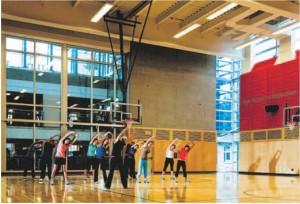
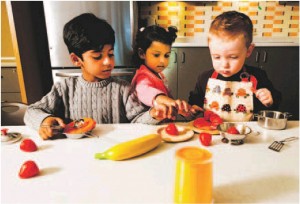
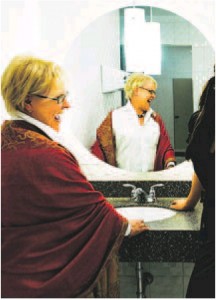 The unique partnership with Concert, together with the generosity of the YMCA’s capital campaign donors, allowed the YMCA to replace and upgrade its facility and to stay in the YMCA’s central location on Burrard Street. Concert is very proud to have contributed significantly to the successful redevelopment of this iconic property, ensuring that the YMCA can continue to meet and expand on its commitment to the downtown community for present and future generations.
The unique partnership with Concert, together with the generosity of the YMCA’s capital campaign donors, allowed the YMCA to replace and upgrade its facility and to stay in the YMCA’s central location on Burrard Street. Concert is very proud to have contributed significantly to the successful redevelopment of this iconic property, ensuring that the YMCA can continue to meet and expand on its commitment to the downtown community for present and future generations.
Robert Lee: It’s about community
It was more than 50 years ago when Robert Lee first joined the Downtown YMCA. He signed up for the usual reasons– wanting to lose a bit of weight and keep in shape–but what kept him going there, three times a week over the next five decades, was the people he met.
“As I became more successful, I particularly valued the fact that within these walls I was just one of the guys to the people with whom I worked out with…people I think of as friends,” he says.
Supporting the downtown Vancouver YMCA is his way of encouraging everyone, both young and old, to become more active. He strongly believes that a healthier lifestyle will create a better life not only for individuals, but also for their families and communities.
“It’s important to have places like the YMCA in our communities, places
where everyone is included,” he says. People can go there to get active and healthier, but they can also be educated at the YMCA, single mothers can find child care that allows them to go out and work, and people who are alone can find a place to belong.”
Robert Lee’s own parents immigrated to Vancouver from Hong Kong in 1916. Born and raised here, Robert lived with his family in Chinatown and then False Creek, attending King Edward High School. He graduated from UBC in 1956 with a Bachelor of Commerce and went on to build the formidable real estate business, the Prospero Group.
Robert Lee is very involved with the community as both a volunteer and philanthropist, wanting to give back to the city that has been instrumental to his success in life.
The Robert Lee YMCA… So Much More Than a Gym
Visit www.robertleeymca.caor call 604-689-9622
The Robert Lee YMCA is about more than just a healthy lifestyle. It’s about bringing people together to strengthen our community.
Inside the new YMCA, you’ll see people working out on the latest fitness equipment, swimming laps in the pool, and taking a yoga class. But you’ll also see seniors learning how to manage their heart condition, young people developing job skills, children discovering new things at preschool, and families spending time together.
This is what the YMCA is all about– helping people of all ages expand their horizons and grow in ways they never imagined.
Take a Look Inside
With more than 92,000 square feet of services and programs, this bright and open-concept six-floor building offers:
– 18,000 square feet of active lifestyle space
– Three fitness studios
– 25-yard UV filtered indoor pool
– Two rooftop playgrounds
– Strength and conditioning zones
– Cafe and lounge
– Gymnasium
– Centre for Reflection
– Squash and racquetball courts
– Computer lab
– Licensed preschool and child care
– Child minding
– Employment training
– Newcomers’ programs
– Youth programs
– Family Development Centre
– Healthy Living Kitchen
– Toy and book lending library
– Underground parking
– Wheelchair accessible facilities and equipment
Get Involved
There are many ways to make the Robert Lee YMCA part of your life.
– Become a YMCA member and fully enjoy the benefits of belonging. There are memberships for adults, children, families, youth and seniors, plus the facility’s inclusive and accessible features ensure that everyone can take part.
– Sign up for a YMCA program, including health and wellness, employment training, children’s programs, youth leadership development and programs for new immigrants.
– Volunteer or work at the YMCA and use your skills to help make people’s lives better. To learn more visit www.robertleeymca.caand click on “Get Involved.”
– Donate to the YMCA and make a difference in the lives of people living in your community. To make a donation, visit www.vanymca.organd click on “Donate Now” or call 604.622.4964.
Membership Info
We offer many types of month-to-month memberships-no locked-in contracts and rates you can afford.
Youth (under 18) Membership -$32
No longer a child, and not yet an adult? If you start a healthy and active lifestyle now, it will stay with you throughout life. Plus, you’ll meet new friends and have fun-guaranteed!
Young Adult Membership -$43
Are you under 35 and want to stay active but are paying student loans and high rent while working for lower pay? The YMCA understands. And, no locked-in contract!
Adult Membership -$53
Access to all YMCA fitness programs to enhance your life. Provides optional 4-month hold for when life takes you away. A partner can join you for just $43 a month and the rate for seniors is $43.
Plus Membership -$81
Looking for that little bit extra to make including fitness in your busy day a bit easier? Our Plus Membership offers extra amenities like towel service, body care products, private steam room and whirlpool. Plus Memberships for seniors over 65 are $65 a month while couples ages 19-64 pay $146 a month.
To learn more, go to www.robertleeymca.caand click “Join.”
Family Membership -$109/$119
Families that are active and play together grow strong together. Includes memberships to the Robert Lee YMCA, access to other YMCA facilities, and member rates for our summer residential and day camps.
Access Membership
YMCA Access Membership removes barriers to fitness, whether they are financial, physical or otherwise. We will work with you to meet your needs and help you reach your goals. At the YMCA, we believe nothing should stand in the way of pursuing a healthy life.
– Fees are subject to applicable taxes.
All memberships include:
– Secure locker access with membership cards
– Access to strength and cardio room
– Group fitness classes like yoga, pilates, and cycle-fit
– Unlimited fitness orientations led by certified YMCA Fitness Leaders
– Aquatics classes and lane swimming, open-pool and on-deck whirlpool and steam room
– Sports programs and open gym for drop-in bas ketball and other activities
– YMCA child minding
– Access to other YMCA of Greater Vancouver membership centres and YMCA health, fitness and recreation centres across Canada
A space for everyone
We reach out
The YMCA has always been at the forefront of innovative outreach programs and community services. Over our 124 years in Vancouver, our programs and resources have evolved and grown with the community, to respond to its changing needs.
We’re here to support the healthy development of people from all walks of life: a recent immigrant eager to embrace a new life in Canada, a single mom who longs for the flexibility and challenge of her own at-home business, a young person stuck in dead-end jobs who is looking for that one big break into something new.
At the YMCA, they’ll find programs that provide a fresh start:
YMCA Connections: Newcomers meet new friends and get the help they need to make Vancouver home. Programs include matching new immigrants with local volunteer hosts, intercultural leadership training for youth, downtown community gardens, conversation clubs and social events.
YMCA New Ventures Network: People learn how to start their own business and achieve their goals. The program is geared towards Employment Insurance recipients who are ready to turn a great idea into successful self-employment, and includes support from experienced business advisors.
YMCA Youth Internship Programs: Youth ages 15 to 30 get the chance to be mentored while learning job skills for success. The goal is to help youth break the no work -no experience cycle, through programs that offer internships within federal government departments and non-profit organizations.
We care about families
On the top two floors of the Robert Lee YMCA there’s a very special place: the YMCA Coast Capital Savings Early Childhood and Family Development Centres. Designed to support families while helping little ones to learn and grow, this bright, welcoming environment features three areas:
Child Care Programs: The YMCA’s toddler and preschool programs help busy parents get kids ready for kindergarten while nurturing positive self-esteem. The programs use the research-based YMCA Playing to Learn curriculum, which sets the foundation for language and literacy, math, science and the arts.
Healthy Living Kitchen: The YMCA’s instructional kitchen helps children, families, adults and seniors learn about healthy cooking and nutrition and provides a place to host gatherings, share recipes, and make friends.
Family Development Centre: This home away from home helps families spend time together and build relationships. Parents also find caring support and resources to help them in their most important job–raising a healthy family. Two rooftop playgrounds encourage safe, active play and a toy lending library will keep them coming back.
YMCA Donors, Partners and Friends Celebrate the opening of the Robert Lee YMCA
The new downtown YMCA has been 30 years in the making. It started with a vision to help more people in the downtown core with services to meet their growing and ever-evolving needs. But it took much more than just a vision to make the Robert Lee YMCA a reality. It took the support of countless YMCA donors, partners and friends who also share the goal of a stronger Vancouver. On Friday, April 30th, that group celebrated the opening of the new centre and the journey that made it possible.
1. Robert Lee cuts the ribbon and declares the new Robert Lee YMCA open. {L-R} YMCA Board Member Keith Purchase, YMCA President and CEO Bill Stewart, Leslie Lee, Carol Lee, Derek Lee, Robert Lee, Lily Lee, Graham Lee and YMCA Board Member John Willson.
2. More than 400 people celebrate the new Robert Lee YMCA with hands raised in the classic “Y” formation.
3. Teck Resources CEO, Donald Lindsay with Susan and John Willson.
4. David Podmore (Chairman and CEO of Concert Properties Ltd.), Darlene Poole, Robert and Lily Lee.
5. YMCA Heritage Club Member, May Brown, enjoys reconnecting with long-time YMCA friends.
6. Bill Stewart highlights Benjamin King, 13 year old member of the Highbury Foundation, as a symbol of the “next generation of philanthropists”.
7. Robert and Diane Conconi of the Robert L. Conconi Foundation.
© Copyright (c) The Vancouver Sun

